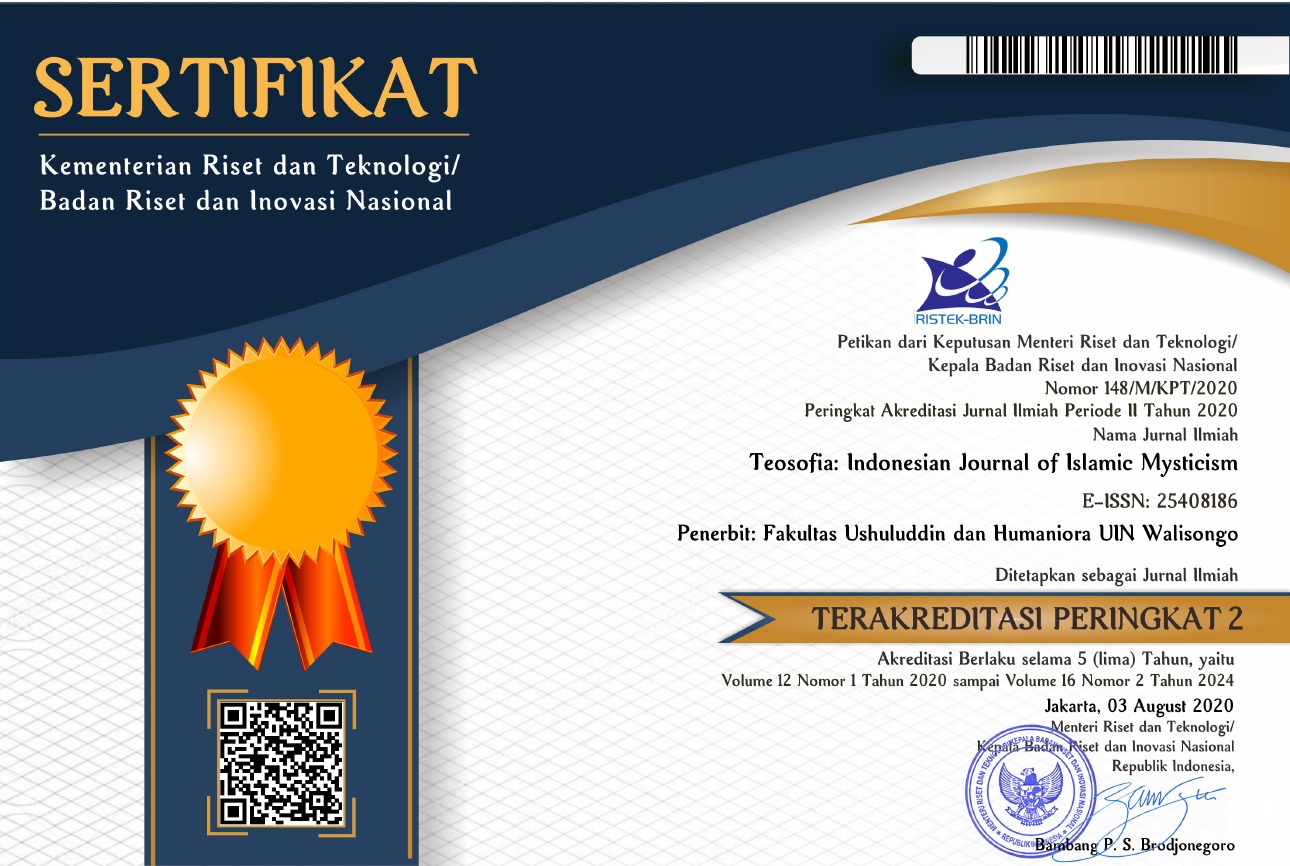Perennialism and the Religious Common Platform of Mystical Tradition in Java
DOI:
https://doi.org/10.21580/tos.v10i2.8439Keywords:
Common Platform, Javanese Religion, Mystical Tradition, Perennialism, PluralismAbstract
This article examines perennials’ understanding through the Javanese mysticism tradition that has developed before and after the arrival of Islam. The focus on perennials in this article is based on recognizing and equality of noble values in every religion that has ever developed in Javanese society, such as Buddhism, Hinduism, and Islam. Previous studies have emphasized that Javanese mysticism is studied from the acculturation of culture with religion. Even this understanding of religion is considered the antithesis of religious exclusivism and conservatism that is currently developing. It is just that the study of Javanese mysticism in the approach of religious perennials is infrequent and limited. This study uses a library research method to reveal the values of mysticism that develop across the religious boundaries of Javanese society. The findings of this study are that there are several teachings of Javanese mysticism, including the conceptions of tantrism, tantularism, and manunggaling kawula gusti. These conceptions illustrate the openness of Javanese society to various religions. They believe that in religions, there is a commonality in ultimate truth or divinity and mystical unity.Downloads
References
Aji, Gutomo Bayu. “Karakter Keberagamaan Di Java Pasca Geertz.” Jurnal Masyarakat Dan Budaya, April 30, 2020. https://doi.org/10.14203/jmb.v22i1.942.
Ardani, Moh. “Manunggaling Kawula Gusti.” In Ensiklopedi Tasawuf, Vol. 2., 779–80. Bandung: Penerbit Angkasa, 2008.
Baharudin, M., and Muhammad Aqil Luthfan. “The Transcendent Unity Behind the Diversity of Religions and Religiosity in the Perspective of Perennial Philosophy and Its Relevance to the Indonesian Context.” Walisongo: Jurnal Penelitian Sosial Keagamaan 25, no. 2 (2017): 325–60. https://doi.org/10.21580/ws.25.2.2025.
Bruinessen, Martin van. “Saints, Politician and Sufi Bureaucrats: Mysticism and Politics in Indonesia’s New Order.” In Sufism and the “Modern” in Islam, edited by Martin van Bruinessen. London: IB Tauris, 2006.
Bruinessen, Martin Van. Contemporary Development in Indonesian Islam: Explaining the “Conservative Turn. Singapore: ISEAS, 2013.
Chodjim, Achmad. Sunan Kalijaga: Mistik Dan Makrifat. 4th ed. Jakarta: Serambi, 2014.
Davar, Mohamad M, and Fatemeh Mohamadi Salamian. “Perennial Philosophy in the Intellectual Foundations of Seyyed Hossein Nasr and Titus Burckhardt.” International Journal of Multicultural and Multireligious Understanding 8, no. 2 (2021): 241–50. https://doi.org/10.18415/ijmmu.v8i2.2295.
Dewantara, Ki Hajar. Majelis Luhur Taman Siswa Bag II A. Yogyakarta, 1967.
Drewes, G.W.J. The Admonitions of Seh Bari. Leiden: The Huque-Martinus Nijhoff, 1969.
Endraswara, Suwardi. Mistik Kejawen: Sinkretisme, Simbolisme Dan Sufisme Dalam Budaya Spiritual Jawa. 3rd ed. Yogyakarta: Narasi, 2004.
Fathurrrahman, Oman. “Sejarah Pengkafiran Dan Marginalisasi Paham Keagamaan Di Melayu Dan Jawa: Sebuah Telaah Sumber.” Analisis: Jurnal Studi Keislaman 9, no. 2 (2011): 447–74. https://doi.org/https://doi.org/10.24042/ajsk.v11i2.624.
Hadiwijono, Harun. Konsepsi Tentang Manusia Dalam Kebatinan Jawa. Jakarta: Penerbit Sinar Harapan, 1983.
Hamayotsu, Kikue. “Conservative Turn? Religion, State and Conflict in Indonesia.” Pacific Affairs 87, no. 4 (2014): 815–25.
Hilmy, Masdar. “Towards a Religiously Hybrid Identity? The Changing Face of Javanese Islam.” Journal of Indonesian Islam 12, no. 1 (2018): 45–68. https://doi.org/10.15642/JIIS.2018.12.1.45-68.
Huxley, Aldous. The Perennial Philosophy. London: Fontana Books, 1959.
Jaspers, Karl. The Perennial Scope of Philosophy. New York: Philosophical Library Inc., 1949.
Johns, A. H. “Sufism as a Category in Indonesian Literature and History.” Journal of Southeast Asian History 2, no. 1 (March 24, 1961): 10–23. https://doi.org/10.1017/S0217781100000260.
———. “The Role of Sufism in the Spread of Islam in the Malaya and Indonesia.” Journal of the Pakistan Historical Society 9 (1961): 143–61.
Koentjaraningrat. Kebudayaan Jawa. Jakarta: Gramedia, 1984.
Kruithof, Maryse. “The Acceptance of New Religions on Java in the Nineteenth Century and the Emergence of Various Muslim and Christian Currents.” Kawalu: Journal of Local Culture 5, no. 1 (2018): 83. https://doi.org/10.32678/kawalu.v5i1.1877.
Magnis-Suseno, Franz. Etika Jawa: Sebuah Analisa Falsafi Tentang Kebijaksanaan Hidup Jawa. Jakarta: PT Gramedia Pustaka Utama, 1991.
Nasr, Seyyed Hossein. Knowledge and The Sacred. Edinburgh: Edinburg University Press, 1981.
Nasuhi, Hamid. Serat Dewaruci: Tasawuf Jawa Yasadipura I. Jakarta: Ushul Press, CeQDA, UIN Jakarta Press, 2009.
Rahardjo, Supratikno. Peradaban Jawa: Dari Mataram Kuno Sampai Majapahit Akhir. Depok: Komunitas Bambu, 2011.
———. “Tinjauan Umum Atas Perangkat Penafsiran Sejarah Kuno.” In Indonesia Dalam Arus Sejarah Kerajaan Hindu-Buddha. Jakarta: PT Ichtiar Baru van Hoeve dan Kementerian Pendidikan dan Kebudayaan RI, 2009.
Randrup, Axel. “The Perennial Philosophy.” The International Journal of Transpersonal Studies 22 (2003): 120–21. https://doi.org/10.1017/S0031819100023330.
Ricklefs, Merle Calvin. Mystic Synthesis in Java: A History of Islamization from the Fourteenth to Early Nineteenth Centuries. Norwalk: EastBridge, 2006.
Rubaidi, Rubaidi. “Javanese Islam: A Blend of Javanese Culture and Islamic Mysticism Viewed from Post-Colonial Perspective.” El Harakah: Jurnal Budaya Islam 21, no. 1 (June 12, 2019): 19–36. https://doi.org/10.18860/el.v21i1.6066.
Sahlan, Asmaun, and Ach Fatchan. “Collaboration Sufism Islamic Adherents Javanese in the Story Puppet of Dewaruci in Java Indonesia.” The Social Sciences 11, no. 21 (2016): 5211–17. DOI: 10.36478/sscience.2016.5211.5217
Salim, Agus. “Javanese Religion, Islam or Syncretism: Comparing Woodward’s Islam in Java and Beatty’s Varieties of Javanese Religion.” Indonesian Journal of Islam and Muslim Societies 3, no. 2 (2013): 223–66. https://doi.org/10.18326/ijims.v3i2.223-266.
Sartini, Heddy Shri Ahimsa-Putra, and Al Makin. “A Preliminary Survey on Islamic Mysticism in Java.” Analisis: Jurnal Studi Keislaman 15, no. 2 (2016): 1–40. https://doi.org/10.24042/ajsk.v16i2.1116.
Schuon, Frithjof. The Transcendent Unity of Religion. Illinois: Theosophical Publishing House, 1984.
Shear, Jonathan. “On Mystical Experiences as Support for the Perennial Philosophy.” Journal of the American Academy of Religion 62, no. 2 (June 27, 1994): 319–42. http://www.jstor.org/stable/1465269.
Simuh. Mistik Islam Kejawen: Raden Ngabehi Ranggawarsita: Suatu Studi Terhadap Serat Wirid Hidayat Jati. Jakarta: UI-Press, 1988.
———. Sufisme Jawa: Transformasi Tasawuf Islam Ke Mistik Jawa. Yogyakarta: Yayasan Bentang Budaya, 1995.
Smith, Charles B. “Perennial Philosophy: From Agostino Steuco to Leibniz.” Journal of the History of Ideas 27, no. 4 (1966): 505–32.
Smith, Huston. “Is There a Perennial Philosophy?” Journal of the American Academy of Religion 55, no. 3 (May 27, 1987): 553–66. http://www.jstor.org/stable/1464070.
Taufik, Zulfan. “Sufisme Perennial Pada Masyarakat Perkotaan: Kasus Padepokan Thaha Jakarta.” Jurnal Penelitian Keislaman 11, no. 1 (2015): 1–16. http://ejurnal.iainmataram.ac.id/index.php/lemlit/article/view/535
Warsito, H.M. Rasjidi, and Bakry Hasbullah. Disekitar Kebatinan. Jakarta: Bulan Bintang, 1973.
Widigdo, Mohammad Syifa Amin. “The Traces of the Bhagavad Gita in the Perennial Philosophy—A Critical Study of the Gita’s Reception among the Perennialists.” Religions 11, no. 5 (2020): 1–10. https://doi.org/10.3390/rel11050229.
Zoetmulder, P.J. Manunggaling Kawula Gusti: Pantheïsme Dan Monisme Dalam Sastra Suluk Jawa. 2nd ed. Jakarta: KITLV, LIPI, Gramedia, 1991.
Downloads
Published
How to Cite
Issue
Section
License
Copyright
The copyright of the received article shall be assigned to the journal as the publisher of the journal. The intended copyright includes the right to publish the article in various forms (including reprints). The journal maintains the publishing rights to the published articles. Therefore, the author must submit a statement of the Copyright Transfer Agreement.*)
Licensing

This work is licensed under a Creative Commons Attribution-ShareAlike 4.0 International License.
In line with the license, authors are allowed to share and adapt the material. In addition, the material must be given appropriate credit, provided with a link to the license, and indicated if changes were made. If authors remix, transform or build upon the material, authors must distribute their contributions under the same license as the original.
_______
*) Authors whose articles are accepted for publication will receive confirmation via email and send a Copyright Transfer Agreement.








